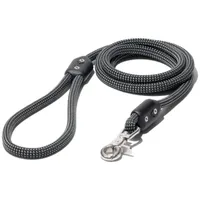Does your dog pull on their leash? If so, you need this trainer's three simple steps
Help stop leash-pulling with some easy training!

We love our pups, but it can be incredibly frustrating when they pull on their leash, right?
Sometimes, a dog just wants to move at their own pace on a walk, whereas we might want to take things more slowly when we’ve got them on one of the best dog leashes. Or, they might not understand that we need to wait before crossing the road. But, dogs can easily learn that pulling on their leash is how they move forward, something we need to address.
And doing so isn’t as difficult as you might think. Award-winning trainer Lisa Burton of Listen Dog Training has explained how to tackle leash-pulling in three easy steps in a new Instagram post, so without further ado, let’s jump straight into her tips.
A post shared by Lisa Burton | Listen Dog Training 💁🏻♀️🥇🐕 (@listendogtraining)
A photo posted by on
If you're looking for a high-quality long leash, then this one is a great option. It's made from dry-treated dynamic climbing rope, meaning it's suitable for strong dogs and lasts a "lifetime" (hence the name). Our tester Sarah tried it out on her dog Duke, and describes it as strong, sturdy and game-changing.
If you’d like to know how to stop a dog pulling on a leash, you’re in the right place. Burton begins by explaining that pulling on the leash yourself will only cause your dog to pull harder in response, so try these three steps instead.
1. Teach: Show your pup that if they give in to leash pressure, they’ll get a treat near you. “Start in a quiet space and reward them for moving with the pressure,” says Burton.
2. Build: Consistency is important. “Build a history of rewarding your dog for responding to gentle leash pressure,” advises Burton, “They’ll learn that staying near you brings good things.”
3. Make it habitual: First, practice in environments with little distraction, and keep repeating! It’s the way you’ll make your pup’s leash manners become automatic.
Get the best advice, tips and top tech for your beloved Pets
“Remember,” Burton continues, “The leash isn’t a steering wheel – it’s a communication tool. Let’s make that conversation rewarding for your dog!”
It’s understandable that your dog might want to pull on their leash. After all, a walk is often the most exciting part of their day – they get to spend time with one of their favorite people in an environment with all sorts of exciting sights, sounds, and smells. What could be better?
That’s why it’s important for us to work together with our pups to help stop leash-pulling. It’s not something that’s likely to stop overnight, but with some patient work, progress should be made. And if you’re not the only one who trains and walks your dog, work with them, too, so that everybody can be on the same page.
If leash-pulling is something you’re really struggling with, you might find this article, from a dog parent who was in the same situation, useful: My dog’s leash-pulling made walks miserable until I helped her reactivity, here’s how.
We’re rounding up the best Black Friday dog deals for dog owners so be sure to check them out!

Adam is a freelance journalist specialising in pets, music and culture, and mental health and wellbeing. He investigates and writes the large majority of news on PetsRadar, and collaborates with veterinary experts to produce informative pet care content.
Adam has a journalism degree from Southampton Solent University and a masters degree in Magazine Journalism from Cardiff University. He was previously senior editor at dog advice website DogTime.com, and has also written for The Independent, GoodToKnow and Healthline.
He owns two rescue cats, Bunny and Dougie, and has also previously had a rabbit, fish and Roborovski dwarf hamsters.

